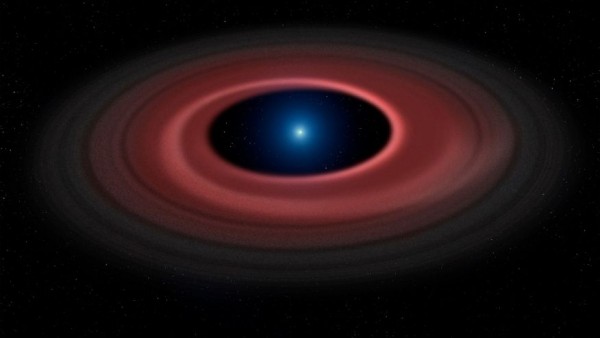Image of Asteroid Ripped Apart by Star Looks Like Saturn's Rings
| Charissa Echavez | | Nov 12, 2015 05:45 AM EST |
(Photo : Mark Garlick and University of Warwick/ESO) Researchers from the University of Warwick have captured an image of a glowing debris ring and have detailed what an asteroid ripped apart actually looks like.
Astronomers have finally captured an image of a glowing debris ring and shed some light on how an asteroid was ripped apart to form the ring.
Scientists from the University of Warwick in UK captured the glowing rings, which comprises of dust particles and debris. These rings are formed when the gravity of a star rips an asteroid apart. The dark, red glow is a result of ultraviolet rays illuminating gases produced during collisions among the debris within the ring.
Like Us on Facebook
Lead researcher Christopher Manser from the Astrophysics Group of the University of Warwick said in a statement "We knew about these debris disks around white dwarfs for over 20 years, but have only now been able to obtain the first image of one of these disks."
University Herald reports that the study was "part of a research analyzing white dwarf stars left behind by dead planetary systems" and was published in the journal Monthly Notices of the Royal Astronomical Society. Compared to the rings surrounding Saturn, the scale of the white dwarf called SDSS1228+1040 is larger and its debris are way bigger.
"The diameter of the gap inside of the debris ring is 700,000 kilometers [434,960 miles], approximately half the size of the Sun and the same space could fit both Saturn and its rings, which are only around 270,000 km [167,770 miles] across," Manser said. "At the same time, the white dwarf is seven times smaller than Saturn but weighs 2500 times more."
Scientists claim that studying this system would give us an idea of what our own solar system will look like once the sun runs out of fuel.
"When we discovered this debris disk orbiting the white dwarf SDSS1228+1040 back in 2006, we thought we saw some signs of an asymmetric shape. However, we could not have imagined the exquisite details that are now visible in this image constructed from twelve years of data - it was definitely worth the wait," said Boris Gänsicke, Manser's colleague, in a statement.
"Over the past decade, we have learned that remnants of planetary systems around white dwarfs are ubiquitous, and over 30 debris disks have been found by now," Gänsicke said. "While most of them are in a stable state, just like Saturn's rings, a handful are seen to change, and it is those systems that can tell us something about how these rings are formed."
Tagsasteroid, asteroid ripped apart, Christopher Manser, University of Warwick, white dwarfs, debris disks, white dwarf stars, Saturn, SDSS1228+1040, solar system, planetary system, Space, glowing debris ring, Saturn's rings, Asteroid Ripped by Dead Star
©2015 Chinatopix All rights reserved. Do not reproduce without permission
EDITOR'S PICKS
-

Did the Trump administration just announce plans for a trade war with ‘hostile’ China and Russia?
-

US Senate passes Taiwan travel bill slammed by China
-

As Yan Sihong’s family grieves, here are other Chinese students who went missing abroad. Some have never been found
-

Beijing blasts Western critics who ‘smear China’ with the term sharp power
-

China Envoy Seeks to Defuse Tensions With U.S. as a Trade War Brews
-

Singapore's Deputy PM Provides Bitcoin Vote of Confidence Amid China's Blanket Bans
-

China warns investors over risks in overseas virtual currency trading
-

Chinese government most trustworthy: survey
-

Kashima Antlers On Course For Back-To-Back Titles
MOST POPULAR
LATEST NEWS
Zhou Yongkang: China's Former Security Chief Sentenced to Life in Prison

China's former Chief of the Ministry of Public Security, Zhou Yongkang, has been given a life sentence after he was found guilty of abusing his office, bribery and deliberately ... Full Article
TRENDING STORY

China Pork Prices Expected to Stabilize As The Supplies Recover

Elephone P9000 Smartphone is now on Sale on Amazon India

There's a Big Chance Cliffhangers Won't Still Be Resolved When Grey's Anatomy Season 13 Returns

Supreme Court Ruled on Samsung vs Apple Dispute for Patent Infringement

Microsoft Surface Pro 5 Rumors and Release Date: What is the Latest?










